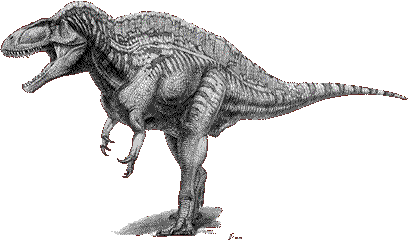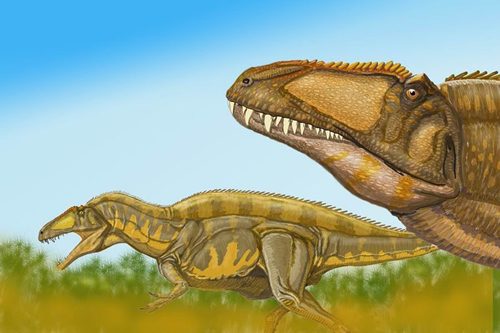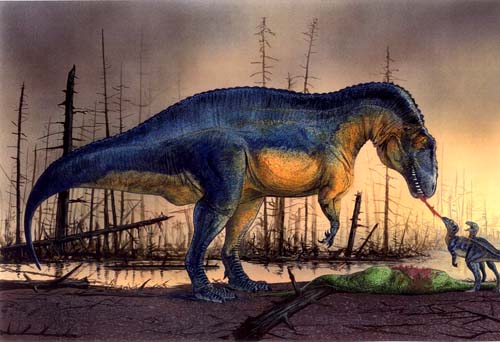Acrocanthosaurus atokensis - Saurischian Dinosaurs
Homepage > Saurischian Dinosaurs - Acrocanthosaurus atokensis
(ak-ro-KANTH-uh-SAWR-us)
"high spine lizard"
Describer Stovall & Langston, 1950
Also Known As --
Type of Species Atokensis
Order Saurischia
SubOrder Theropoda
InfraOrder --
Micro-Order --
Family Carcharodontosauridae
Size 10-13 feet (3-4 meters) in length
Period Cretaceous Early Aptian Albian
Fossilsite Antlers Formation, Oklahoma, Antlers Formation, Paluxy River
Formation, Twin Mountains Formation, Texas, Middle Cedar Mountain Formation,
Utah, US
Diet Bipedal Carnivore
 Acrocanthosaurus
is known from incomplete skeletons and teeth. This large carnivorous dinosaur
walked on two long, powerful legs. Acrocanthosaurus is famous for the
tall spines on its back, and tail. The spines on some large individuals
were as much as 2 feet (60 centimeters) tall, which gave this dinosaur
a powerful looking profile. The tall vertebral spines on the neck, back
and tail, served as attachment points for muscles. And may have been useful
in grabbing, holding, or dismembering its prey.
Acrocanthosaurus
is known from incomplete skeletons and teeth. This large carnivorous dinosaur
walked on two long, powerful legs. Acrocanthosaurus is famous for the
tall spines on its back, and tail. The spines on some large individuals
were as much as 2 feet (60 centimeters) tall, which gave this dinosaur
a powerful looking profile. The tall vertebral spines on the neck, back
and tail, served as attachment points for muscles. And may have been useful
in grabbing, holding, or dismembering its prey.
Acrocanthosaurus existed in what is now North America during the mid-Cretaceous Period. This dinosaur is one of the largest theropods, approaching 40 feet (12meters) in length, and having a weight up to about 2.6 tons. It is likely that this dinosaur was the largest theropod in its ecosystem and likely an apex predator which possibly preyed on large sauropods and ornithopods.

The most noticeable characteristic of this dinosaur was its row of tall dorsal spines, located on the vertebrae of the neck, back, hips and upper tail, which could be more than 2 1/2 times the height of the vertebrae from which they extended. This characteristic has been noticed on other dinosaurs such as Spinosaurus a. These two animals were not related, but the spines of Spinosaurus a. are known to have grown as much as 6.5 feet (2 meters) tall, about 11 times taller than the bodies of its vertebrae. The function of the spines is not fully understood, it is believed that it may have been involved in communication, fat storage, or temperature control.

Image courtesy of John Bindon
Discovery
Acrocanthosaurus fossils have been found in what is now the USA, in Oklahoma,
Texas, and Utah. It was named by paleontologists Stovall and Langston
in 1950. Acrocanthosaurus atokensis is the type species. Many Acrocanthosaurus
tracks have also been found. Foot print tracks discovered in Texas are
believed to have been made by Acrocanthosaurus, but there is no direct
association with skeletal remains. A good specimen of Acrocanthosaurus
is 54% complete, from Oklahoma.